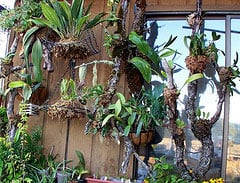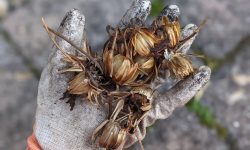If you’re an orchid lover, chances are you have a healthy collection of these beautiful flowers. But what do you do when your orchids start to outgrow their potting mix? It’s time to mount them!
Mounting orchids is a great way to give them the extra support they need, and it can also help increase air circulation around the roots.
- Gather the materials you will need: an orchid, potting mix, a container, and water
- Inspect your orchid for any pests or diseases
- If any are present, treat them accordingly
- Choose a pot that is slightly larger than the root ball of your orchid
- This will give the roots room to grow
- Fill the pot with potting mix, making sure to leave room at the top for watering
- Gently tap the pot on the ground to settle the mix
- Place your orchid in the pot and fill in around it with more potting mix if necessary
- Water well and allow to drain thoroughly before moving to its final location
Mounted Orchids – How to & Care Tips! – Orchid Care for Beginners
How Do You Mount Orchid Plants?
When it comes to mounting orchids, there are a few things you’ll need to take into consideration. The type of orchid you have, the size and weight of the plant, and the material you’ll be using to mount it.
For most Orchids, a simple wooden plank will do just fine.
It’s important that the wood is untreated, as chemicals in treated wood can be harmful to your Orchid. You’ll also want to make sure the plank is wide enough and has enough surface area to accommodate your Orchid’s root system.
Once you have your wood, simply drill a few holes into it (being careful not to drill all the way through) and screw in some eye hooks.
You can then thread some fishing line or wire through the eye hooks and tie it off securely. Make sure the lines or wires are long enough so that when you hang your Orchid, the roots will have plenty of room to spread out.
If you’re using wire instead of fishing line, you can wrap the wire around small pieces of cork before attaching it to the eye hooks.
This will give your Orchid something soft to grip onto and will help prevent any damage to the roots.
Now all that’s left is to Hang your Orchid up! Find a spot in your home with bright indirect light and good air circulation, and Suspend your Orchid from its new mount.
Water regularly (about once per week), making sure not to get water on any leaves or flowers, and soon you should see new growth!
What Can I Mount My Orchid On?
One of the most common questions we get asked here at Orchid Care HQ is what kind of surface or material is best to mount an orchid on. There are a few different options available, so we’ll go over each one in turn and help you decide which will work best for your needs.
The first option is tree bark.
This can be either real bark from a living tree, or slabs of artificial bark that are sold specifically for orchids. Bark offers a natural, organic look and feel, and it also provides good drainage and air circulation around the roots of the plant. The downside to bark is that it can be difficult to keep moist, so you’ll need to water more frequently than with other materials.
Another popular option is cork. Cork comes in both sheet form and as pre-formed cylinders (called “cork tubes”). It has a similar appearance to bark, but it tends to hold moisture better so you won’t have to water as often.
Cork also provides good drainage and air circulation. One downside to cork is that it can be expensive, especially if you need a lot of it to cover a large mounting surface.
A third option is plastic mesh.
This material is usually used in conjunction with another material like cork or bark; the mesh helps keep everything in place while providing good drainage and airflow around the roots. Plastic mesh can be cut easily with scissors so you can custom-fit it to any size surface area. The main downside to plastic mesh is that it doesn’t look very attractive on its own, but this can be remedied by covering it with moss or another type of plant material before attaching your orchid.
So which material should you choose? Ultimately, it depends on your personal preferences and what will work best given the conditions in your home (e.g., humidity levels, amount of light, etc.).
What Kind of Wood Can You Mount Orchids On?
When it comes to mounting orchids, there are a few different types of wood that can be used. One option is cork bark, which is often used because it has a rough surface that can help the orchid’s roots grip and anchor onto the bark. Additionally, cork bark is lightweight and easy to work with when mounting an orchid.
Another type of wood that can be used for mounting orchids is driftwood. Driftwood provides a more natural look for mounted orchids and can also help to create better drainage since it is full of holes and crevices. However, driftwood can be heavier than cork bark and may not be as easy to work with when mounting an orchid.
Finally, tree ferns are another type of wood that can be used for mounting orchids. Tree ferns provide good drainage and aeration for the roots of the orchid while also being lightweight and easy to work with. Additionally, tree ferns have a natural look that goes well with most mounted orchids.
How Do You Wood Mount an Orchid?
Orchids are one of the most popular and beautiful houseplants. They come in many different colors, shapes, and sizes. Many people choose to wood mount their orchids because it is a simple and elegant way to display them.
There are a few things you will need before you begin: an orchid, some wooden mounting boards, sphagnum moss, wire ties, and a sharp knife. You will also need a potting mix that is specifically for orchids.
To start, soak the sphagnum moss in water until it is saturated.
Then, wrap it around the roots of your orchid so that they are completely covered. Next, secure the moss with wire ties.
Now you are ready to attach your orchid to the wooden mounting board.
First, make sure that the board is the correct size for your plant. If it is too big, your plant will not have enough support and may fall off; if it is too small, there will not be enough room for the roots to grow properly. Once you have found a board that is the right size, use the knife to make two small slits in the center of it.
These slits should be just big enough for the wire ties to fit through.
Thread the wire ties through these slits and then tie them tightly around the base of your plant (where the stem meets the roots). The goal here is to make sure that your plant is securely attached to the board so that it will not fall off later on.
Now all you have to do is find a place for your new wood-mounted Orchid!

Credit: www.justaddiceorchids.com
Orchid Mounting Kit
If you’re looking for a way to display your orchids that is both attractive and functional, then you need an orchid mounting kit. Orchid mounts are available in a variety of materials, such as wood, plastic, and metal. There are also a variety of sizes and shapes to choose from.
When selecting an orchid mount, it’s important to consider the size and type of your orchid. For example, if you have a large or heavy-blooming orchid, then you’ll need a sturdier mount. On the other hand, if you have a small or delicate orchid, then a more lightweight mount would be better.
Orchid mounts can be placed on shelves, windowsills, desks, tables – really anywhere that gets good light and has some airflow. Just make sure that the surface is clean and smooth so that your orchid doesn’t get damaged.
Once you’ve selected the perfect mount for your orchid, it’s time to pot it up!
Make sure to use well-draining potting mix , and water your plant regularly (but don’t overdo it). With proper care, your mounted orchid will thrive and provide you with beautiful blooms for years to come!
How to Mount Orchids on Palm Trees
If you’re looking for a unique way to display your orchids, why not try mounting them on palm trees? It’s a relatively simple process and it’ll definitely add some flair to your home or garden! Here’s what you need to know:
First, choose the right type of orchid. You’ll want to select an Orchidaceae that is epiphytic, meaning it grows naturally in tree crevices without needing soil. Some good examples include the Phalaenopsis (moth orchid), Dendrobium, and Oncidium varieties.
Next, find a healthy palm tree that gets plenty of sunlight but isn’t too hot. Make sure the tree has smooth bark so your orchids will have something to grip onto. If necessary, you can sand down any rough spots with fine-grit sandpaper.
Now it’s time to prepare your orchids for mounting. Start by removing any existing potting mix from the roots and gently washing away any dirt or debris. Then, using sharp scissors, trim off any dead leaves or roots.
Finally, dip the roots in a rooting hormone solution (available at most garden stores). This will help encourage new growth.
Once your orchids are ready, it’s time to start mounting them on the palm tree!
Begin by tying each plant securely around the trunk with soft gardening twine. Be careful not to damage the bark as you tie them in place. Next, using small nails or screws, attach wire mesh “baskets” to the trunk at various heights (make sure they’re big enough to comfortably fit your plants).
These baskets will provide support for the roots as they grow into their new homes. Finally, fill each basket with a well-draining potting mix and water thoroughly.
Mounting orchids on palm trees is a great way to add some tropical flair to your landscape – and it’s surprisingly easy too!
What Type of Orchids are Best for Mounting?
When it comes to choosing the perfect orchids for mounting, a few varieties stand out. Epiphytic orchids like Vandas and Dendrobiums are excellent choices, as they naturally grow on trees and thrive when mounted. Additionally, some species of Oncidium orchids, such as the Odontoglossum and Miltoniopsis, adapt well to the mounting technique. These orchids offer a beautiful and dynamic display when mounted on a tree bark or other suitable materials.
How to Hang Orchids Indoors
If you’re looking for a beautiful, unique way to add some life to your home, look no further than the orchid! These stunning flowers are relatively easy to care for and make a wonderful addition to any indoor space. Here’s everything you need to know about how to hang orchids indoors:
Orchids come in many different varieties, so it’s important to choose one that will do well in your particular climate. If you live in a warm, humid environment, Phalaenopsis orchids are a good option. If your home is on the drier side, Cattleya orchids would be a better choice.
Once you’ve selected the right variety of orchid for your home, it’s time to get started on hanging them!
The first step is to find the perfect spot for your orchids. They should be in an area with bright, indirect sunlight and good airflow.
A south-facing window is ideal. Orchids also like humidity, so if possible, place them near a bathroom or kitchen where they can benefit from the extra moisture in the air.
Once you’ve found the perfect spot for your orchids, it’s time to get them ready for hanging.
Begin by gently removing them from their potting mix and shaking off any excess dirt and debris. Next, use sharp scissors or pruning shears to trim away any dead roots – these won’t do anything helpful for your plant and can actually rot and damage living tissue if left unchecked. Finally, cut back any yellowing leaves – these indicate that the plant is stressed and likely won’t bloom again until given a chance to rest.
With your plant all prepped and ready to go, it’s time to start hanging! The easiest way to do this is by using an invisible wire hanger – simply thread the wire through the potting mix at the base of the plant (being careful not injure any roots) and then twist it around itself several times before looping it over something sturdy like a ceiling hook . You want there tp be some slack in the wire so that as your plant grows larger over time ,it doesn’t become constricted .
And that’s all there is too it ! With proper care ,your beautiful indoor orchids will thriveand bring happiness into your homefor years toeome !
Conclusion
Orchids are beautiful, exotic flowers that make a stunning addition to any home. Though they may seem delicate, with proper care orchids can thrive indoors. When it comes to mounting orchids, there are a few things to keep in mind.
First, choose a mount that is well-ventilated and has good drainage. Be sure to soak the mount in water for at least an hour before adding your plant. It’s also important to use Sphagnum moss, which will help hold moisture around the roots of the plant.
To attach the orchid, simply tie it gently to the mount with some fishing line or cotton thread. With proper care, your mounted orchid will bloom for years to come!






